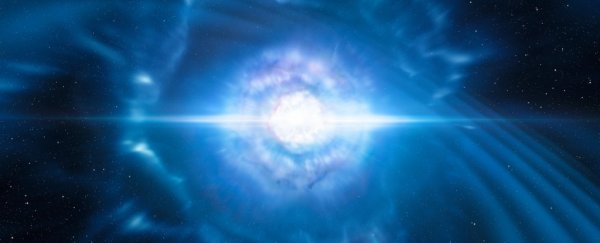
This is direct empirical demonstration that two stars will merge and make a mess while producing hte heavy elements. Recall our nuclear theory only gets us up to iron and says little else as you deal higher including far too many common elements..
This is actually good news if only because it provides a proven separate mechanism.
It is all doing what our theory says it will.
When Neutron Stars Collide, They Explode Like a Mini Big Bang
07 November 2024
An artist's impression of colliding neutron stars. (ESO/L. Calçada/M. Kornmesser)
https://www.sciencealert.com/when-neutron-stars-collide-they-explode-like-a-mini-big-bang?
In August 2017, humanity observed a wonder. For the first time, we got to see two neutron stars colliding, an event observed by telescopes around the world, alerted by the gravitational ruckus as the two objects spiraled in to merge and form a black hole.
Even at the time, we knew that that one event, a kilonova explosion named AT2017gfo, would give us sufficient scientific data to gnaw on for years to come. And so it has proven. Now, scientists have pieced together data from multiple telescopes to reconstruct the days after the kilonova took place, and its violently expanding fireball that gave birth to a flurry of heavy elements.
It's an event that evolved, says a research team led by astrophysicist Albert Sneppen of the Niels Bohr Institute at the University of Copenhagen, much like the Big Bang, with a hot soup of particles that cooled and coalesced into matter.
"This astrophysical explosion develops dramatically hour by hour, so no single telescope can follow its entire story. The viewing angle of the individual telescopes to the event are blocked by the rotation of the Earth," Steppen explains.
"But by combining the existing measurements from Australia, South Africa, and the Hubble Space Telescope we can follow its development in great detail. We show that the whole shows more than the sum of the individual sets of data."
One fascinating thing that the observations of AT2017gfo showed was the creation of heavy elements. A lot of elements are forged inside stars, where core fusion processes smash atoms together to make heavier ones.
But there's a cutoff point for this – stars can't fuse elements heavier than iron, because the energy it takes to do so is greater than the energy produced by fusion.
It takes a very energetic event to make heavier elements, such as a supernova explosion. AT2017gfo showed that neutron star kilonovae are also productive heavy element factories – in the light emitted during the explosion, astronomers detected the signature of strontium.
Steppen and his colleagues have taken this analysis a step further. By carefully studying multiple datasets, they were able to observe the hour-by-hour evolution of the kilonova, and the formation of heavy elements, known as r-process elements, within.
When the two neutron stars collide, the initial kilonova of exploded neutron star guts is extremely hot, billions of degrees, comparable to the heat of the Big Bang. In this hot, plasmatic environment, elementary particles like electrons can whizz around freely, unbound.
As the kilonova expands and cools, the particles snatch each other up and become atoms. This, the researchers say, is similar to a period early in the history of the Universe known as the Epoch of Recombination.
Around 380,000 years after the Big Bang, the Universe cooled enough so that the particles glopping around in the primordial plasma soup could combine into atoms. The plasma soup had scattered light instead of allowing it to propagate, and this 'recombination' meant that light could finally stream through the Universe.
The process of combination observed in the neutron star kilonova is very similar to what we think happened during the Epoch of Recombination, suggesting that kilonovae could be a powerful laboratory for probing the evolution of the early Universe, in miniature.
The researchers were also able to confirm the presence of strontium and yttrium in the evolving kilonova, bolstering support for kilonova explosions as a source of heavy elements in the Universe.
"We can now see the moment where atomic nuclei and electrons are uniting in the afterglow," says astrophysicist Rasmus Damgaard of the Niels Bohr Institute.
"For the first time we see the creation of atoms, we can measure the temperature of the matter and see the micro physics in this remote explosion. It is like admiring three cosmic background radiation surrounding us from all sides, but here, we get to see everything from the outside. We see before, during and after the moment of birth of the atoms."
Now that's metal.
The research has been published in Astronomy & Astrophysics.
No comments:
Post a Comment